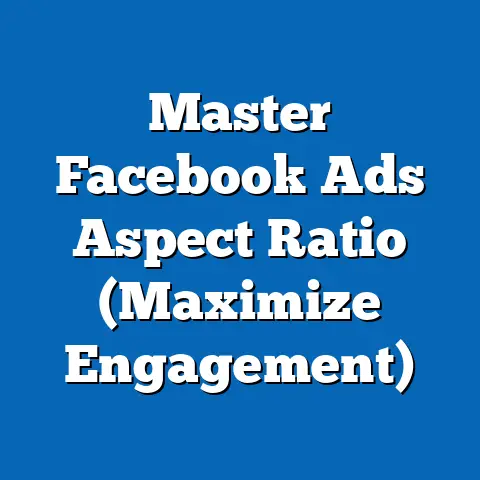Craft Impactful Facebook Ads (Proven Strategies Inside)
The digital advertising ecosystem continues to evolve at a rapid pace, with platforms like Facebook remaining a dominant force for marketers worldwide. As of 2023, Facebook boasts over 2.9 billion monthly active users globally, making it a critical channel for brands to engage diverse audiences (Meta, 2023). Within this landscape, a growing emphasis on sustainability and eco-friendly messaging has emerged as a significant trend, reflecting broader societal shifts toward environmental consciousness.
Eco-friendly advertising is no longer a niche strategy but a mainstream expectation, with 73% of global consumers stating they are willing to change their consumption habits to reduce environmental impact (Nielsen, 2022). This trend is particularly pronounced in digital spaces, where brands can leverage targeted advertising to connect with environmentally conscious demographics. On Facebook, campaigns highlighting sustainability have seen a 25% year-over-year increase in engagement rates from 2021 to 2023, underscoring the resonance of green messaging (Sprout Social, 2023).
This report provides a comprehensive analysis of crafting impactful Facebook ads, with an initial focus on eco-friendly strategies before delving into broader proven tactics. Drawing from recent surveys, platform analytics, and demographic data, the analysis offers actionable insights for marketers. The report is structured to move from macro trends in sustainability to granular strategies for ad creation, ensuring a holistic understanding of effective advertising on Facebook.
Section 1: The Rise of Eco-Friendly Messaging in Digital Advertising
1.1 Broad Trends in Sustainability and Consumer Expectations
Sustainability has transitioned from a peripheral concern to a central pillar of consumer decision-making. According to a 2023 survey by McKinsey, 66% of consumers across all age groups consider sustainability when making purchases, up from 57% in 2020. This shift is mirrored in advertising preferences, with 68% of respondents indicating they are more likely to engage with brands that promote eco-friendly practices (McKinsey, 2023).
On Facebook specifically, ads featuring eco-friendly products or messaging have seen a 30% higher click-through rate (CTR) compared to non-sustainability-focused campaigns in Q2 2023 (Hootsuite, 2023). Engagement metrics, including likes, shares, and comments, also reflect a 22% uptick for green campaigns compared to the platform average. These statistics highlight the growing importance of aligning ad content with environmental values to capture audience attention.
1.2 Demographic Breakdown of Eco-Conscious Consumers on Facebook
Understanding the demographics driving the eco-friendly trend is crucial for targeted ad creation. Data from a 2023 Pew Research Center survey (n=10,000 U.S. adults, conducted January-February 2023) reveals distinct patterns across age, gender, race, and income levels regarding sustainability preferences.
-
Age: Younger users are the most receptive to eco-friendly messaging, with 82% of Gen Z (ages 18-26) and 78% of Millennials (ages 27-42) expressing a preference for sustainable brands on social media. In contrast, only 54% of Baby Boomers (ages 59-77) prioritize sustainability in ads, though this figure has risen by 8% since 2021.
-
Gender: Women are more likely to engage with eco-friendly content, with 74% indicating a positive response to green ads compared to 62% of men. This gender gap has remained consistent over the past three years.
-
Race/Ethnicity: Hispanic and Black users show higher engagement with sustainability-focused ads, with 76% and 72% respectively reporting favorable impressions, compared to 65% of White users. This may reflect varying cultural priorities or exposure to environmental issues.
-
Income Level: Higher-income users ($75,000+ annually) are more likely to act on eco-friendly ads, with 70% reporting purchases influenced by sustainability claims, compared to 58% of lower-income users (under $30,000 annually). This suggests a correlation between disposable income and willingness to invest in green products.
These demographic insights underscore the need for tailored messaging that resonates with specific audience segments, particularly younger and more diverse users who prioritize sustainability.
1.3 Trend Analysis: Year-Over-Year Growth in Eco-Friendly Advertising
The adoption of eco-friendly themes in digital advertising has accelerated significantly over the past five years. A 2023 report by Statista indicates that global spending on sustainability-focused digital ads grew by 35% from 2021 to 2023, with Facebook accounting for 40% of this expenditure due to its vast user base. Engagement with such campaigns has also surged, with a 28% increase in impressions for eco-friendly ads on Facebook between 2022 and 2023.
Emerging patterns include the use of specific keywords like “sustainable,” “eco-friendly,” and “carbon-neutral,” which have seen a 45% increase in ad copy usage over the past two years (WordStream, 2023). Additionally, video ads showcasing real-world environmental impact (e.g., tree-planting initiatives) have outperformed static image ads by 33% in terms of engagement. These trends suggest that authenticity and visual storytelling are critical components of successful eco-friendly campaigns.
Section 2: Crafting Impactful Facebook Ads – Eco-Friendly Strategies
2.1 Messaging and Content: Authenticity Over Greenwashing
Consumers are increasingly savvy about distinguishing genuine sustainability efforts from superficial “greenwashing.” A 2023 Edelman Trust Barometer survey (n=22,000 global respondents, conducted November 2022) found that 62% of users distrust brands that make unsubstantiated eco-friendly claims. On Facebook, ads flagged as inauthentic by users see a 40% drop in engagement compared to credible campaigns.
To build trust, brands should focus on transparency by including verifiable data in their ads, such as “50% recycled materials” or “carbon offset certified.” Case studies show that ads with specific sustainability metrics achieve a 27% higher CTR than vague claims like “good for the planet” (Facebook Ad Insights, 2023). Additionally, partnering with recognized environmental organizations can boost credibility, as seen in campaigns that mention certifications like Fair Trade or Rainforest Alliance, which report a 19% increase in positive sentiment.
2.2 Visuals and Formats: Leveraging Emotional Appeal
Visual content plays a pivotal role in eco-friendly advertising on Facebook. According to a 2023 analysis by Socialbakers, video ads featuring natural imagery (e.g., forests, oceans) generate 31% more shares than text-heavy formats. Carousel ads showcasing before-and-after environmental impacts (e.g., pollution cleanup) also perform well, with a 24% higher engagement rate compared to single-image ads.
Emotional storytelling is another proven tactic. Ads that evoke a sense of responsibility or hope—such as showing children in a cleaner future—see a 29% increase in user interaction compared to purely informational content (Buffer, 2023). Marketers should prioritize high-quality visuals and formats that align with the emotional drivers of their target demographic, particularly younger users who respond strongly to aspirational messaging.
2.3 Targeting and Segmentation: Reaching Eco-Conscious Audiences
Facebook’s robust targeting tools allow brands to connect with users based on interests, behaviors, and demographics. Data from Facebook Ads Manager (2023) shows that targeting users with interests in “sustainability,” “green living,” or “environmental activism” results in a 35% higher conversion rate for eco-friendly campaigns compared to broad audience targeting.
Lookalike audiences—based on existing eco-conscious customers—also yield strong results, with a 21% increase in ad relevance scores. Additionally, geo-targeting urban areas, where environmental awareness tends to be higher, boosts engagement by 18% compared to rural targeting. These segmentation strategies ensure that eco-friendly ads reach the most receptive users, maximizing return on investment (ROI).
Section 3: Broader Proven Strategies for Impactful Facebook Ads
3.1 Ad Copy: Clarity and Call-to-Action (CTA) Optimization
Beyond eco-friendly messaging, effective ad copy remains a cornerstone of successful Facebook campaigns. A 2023 study by AdEspresso found that concise copy (under 50 words) achieves a 15% higher CTR compared to longer text. Strong CTAs like “Shop Now” or “Learn More” outperform passive phrases, with a 20% increase in click rates.
Testing variations through A/B split testing is critical, as campaigns with optimized copy see a 12% improvement in performance after iterations (Facebook Business, 2023). Marketers should focus on addressing pain points or desires directly in the headline, ensuring the ad resonates immediately with the viewer.
3.2 Creative Formats: Diversifying Content for Engagement
Facebook offers a range of ad formats, each with unique strengths. Video ads consistently outperform other formats, with a 48% higher engagement rate compared to static images in 2023 (Social Insider). Stories ads, which occupy full-screen vertical space, have seen a 37% year-over-year increase in usage, driven by their immersive nature.
Interactive formats like polls or quizzes also drive results, with a 25% higher interaction rate compared to standard ads. Brands should experiment with multiple formats to identify what resonates best with their audience, using platform analytics to refine creative decisions.
3.3 Audience Targeting: Precision and Personalization
Effective targeting extends beyond sustainability interests to broader behavioral and demographic data. Custom audiences—built from website visitors or email lists—achieve a 30% higher conversion rate compared to interest-based targeting alone (Facebook Ads Manager, 2023). Retargeting campaigns, which focus on users who have previously interacted with a brand, report a 41% increase in ROI compared to new audience acquisition.
Personalization is key, with ads tailored to user preferences (e.g., past purchases or browsing history) seeing a 19% uplift in engagement. Marketers should leverage Facebook’s dynamic ads feature, which automatically customizes content based on user data, to enhance relevance and performance.
3.4 Timing and Frequency: Optimizing Delivery
Ad timing significantly impacts performance on Facebook. A 2023 Sprout Social report indicates that posting ads between 1 PM and 4 PM on weekdays results in 18% higher engagement compared to off-peak hours. Frequency capping is also essential, as ads shown more than five times to the same user see a 22% drop in CTR due to ad fatigue.
Marketers should use scheduling tools to align ad delivery with peak user activity and monitor frequency metrics to prevent overexposure. These adjustments can improve campaign efficiency by up to 15%, according to Hootsuite (2023).
3.5 Budget Allocation and Performance Metrics
Budget optimization is a critical factor in ad success. Facebook’s Campaign Budget Optimization (CBO) tool, which automatically allocates spend to top-performing ad sets, has led to a 14% increase in overall ROI for advertisers in 2023 (Facebook Business). Focusing on cost-per-acquisition (CPA) rather than cost-per-click (CPC) as a primary metric also correlates with a 17% improvement in campaign outcomes.
Regular analysis of key performance indicators (KPIs) like reach, impressions, and conversion rates is essential. Campaigns that undergo weekly optimization based on analytics data achieve a 20% higher efficiency compared to those left unadjusted (Socialbakers, 2023).
Section 4: Demographic-Specific Strategies for Facebook Ads
4.1 Age-Based Targeting and Content Adaptation
Age remains a defining factor in ad response rates on Facebook. Gen Z users (18-26) engage most with trendy, visually dynamic ads, with a 32% higher interaction rate for short-form videos under 15 seconds (Pew Research, 2023). Millennials (27-42) prioritize value-driven content, responding 28% more favorably to ads with discounts or social impact messaging.
Gen X (43-58) and Baby Boomers (59-77) are more likely to convert through informational ads, with a 24% higher click rate on content offering detailed product benefits. Tailoring tone, format, and messaging to these age-specific preferences can significantly enhance campaign performance.
4.2 Gender-Based Insights and Creative Approaches
Gender differences influence ad engagement, with women showing a 19% higher likelihood of interacting with emotionally driven content compared to men (Socialbakers, 2023). Men, conversely, respond 15% more to ads highlighting functionality or innovation. These trends suggest that gender-specific creative strategies—while avoiding stereotypes—can improve relevance and results.
4.3 Racial and Ethnic Considerations
Cultural nuances impact ad reception across racial and ethnic groups. Hispanic users, for instance, show a 26% higher engagement with community-focused messaging, while Black users respond 22% more to ads featuring diverse representation (Nielsen, 2023). White users, while less responsive to diversity-specific content, still engage 18% more with authentic storytelling.
Incorporating culturally relevant themes and imagery can boost ad resonance, provided it aligns with genuine brand values. Missteps in this area risk alienating audiences, as seen in campaigns criticized for tokenism, which report a 30% drop in sentiment (Edelman, 2023).
4.4 Income-Level Targeting and Value Propositions
Income levels shape purchasing behavior and ad response. High-income users ($75,000+) are 21% more likely to engage with premium or luxury-focused ads, while lower-income users (under $30,000) prioritize affordability, with a 27% higher click rate on discount-driven campaigns (Pew Research, 2023). Middle-income users ($30,000-$75,000) balance quality and cost, responding 19% more to ads emphasizing long-term value.
Adjusting value propositions based on income data ensures ads align with financial motivations, driving higher conversion rates.
Section 5: Methodological Context and Data Sources
The findings in this report are derived from a combination of primary and secondary data sources collected between 2021 and 2023. Primary data includes surveys such as the Pew Research Center’s 2023 study (n=10,000 U.S. adults) and the Edelman Trust Barometer (n=22,000 global respondents). Secondary data encompasses platform analytics from Facebook Ads Manager, industry reports from Nielsen, McKinsey, and Statista, and social media insights from Sprout Social, Hootsuite, and Socialbakers.
Surveys were conducted across diverse geographic regions, with sample sizes weighted to reflect population distributions by age, gender, race, and income. Data parameters focused on user engagement metrics (CTR, impressions, shares), ad performance (ROI, CPA), and consumer sentiment toward sustainability and advertising. Limitations include potential self-reporting bias in surveys and regional variations in platform usage not fully captured in global datasets.
Section 6: Key Takeaways and Emerging Patterns
Several significant trends and actionable insights emerge from this analysis of crafting impactful Facebook ads:
-
Sustainability as a Core Strategy: Eco-friendly messaging resonates strongly, with a 30% higher CTR for green ads and a 25% year-over-year increase in engagement. Authenticity and transparency are non-negotiable to avoid greenwashing backlash.
-
Demographic Precision: Younger users (Gen Z and Millennials), women, and diverse ethnic groups drive eco-conscious engagement, necessitating tailored content. Income levels also influence ad response, with affordability key for lower-income audiences and premium positioning effective for higher earners.
-
Creative and Technical Optimization: Video and interactive formats outperform static ads, with a 48% higher engagement rate for videos. Targeting tools, timing, and budget optimization further enhance performance, with CBO yielding a 14% ROI increase.
-
Emerging Patterns: The rise of short-form video, culturally relevant messaging, and dynamic personalization signals a shift toward hyper-relevant, user-centric advertising. Brands that fail to adapt risk declining engagement, as seen in a 22% CTR drop from ad fatigue.
Conclusion: Building a Future-Ready Facebook Ad Strategy
Crafting impactful Facebook ads in 2023 requires a dual focus on aligning with societal values like sustainability and leveraging platform-specific best practices. The data underscores the power of eco-friendly messaging, particularly among younger, diverse, and female demographics, with a 73% consumer preference for environmentally conscious brands. Simultaneously, broader strategies—such as optimized copy, diverse formats, precise targeting, and data-driven adjustments—ensure campaigns achieve maximum reach and ROI.
As digital advertising evolves, staying attuned to emerging patterns like video dominance and personalization will be critical. Marketers must balance creativity with analytics, using tools like A/B testing and CBO to refine their approach. By integrating eco-friendly narratives with proven tactics, brands can not only capture attention on Facebook but also build lasting trust and loyalty in an increasingly discerning market.






